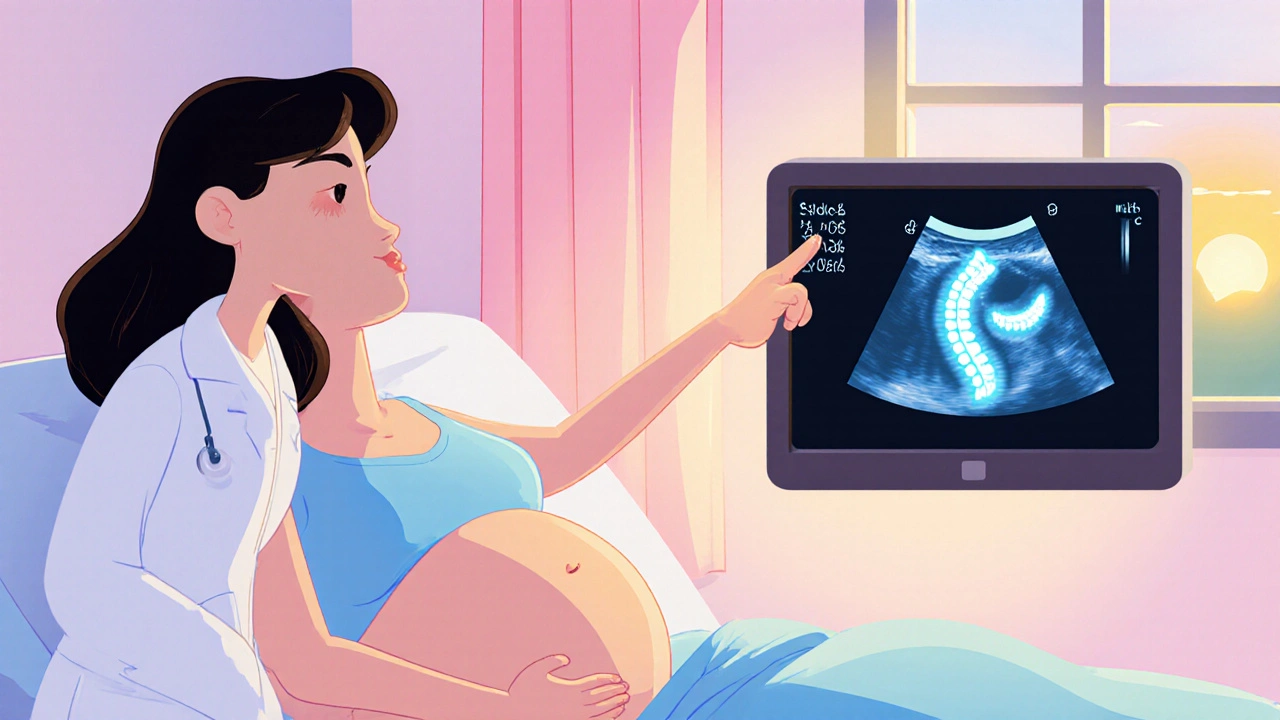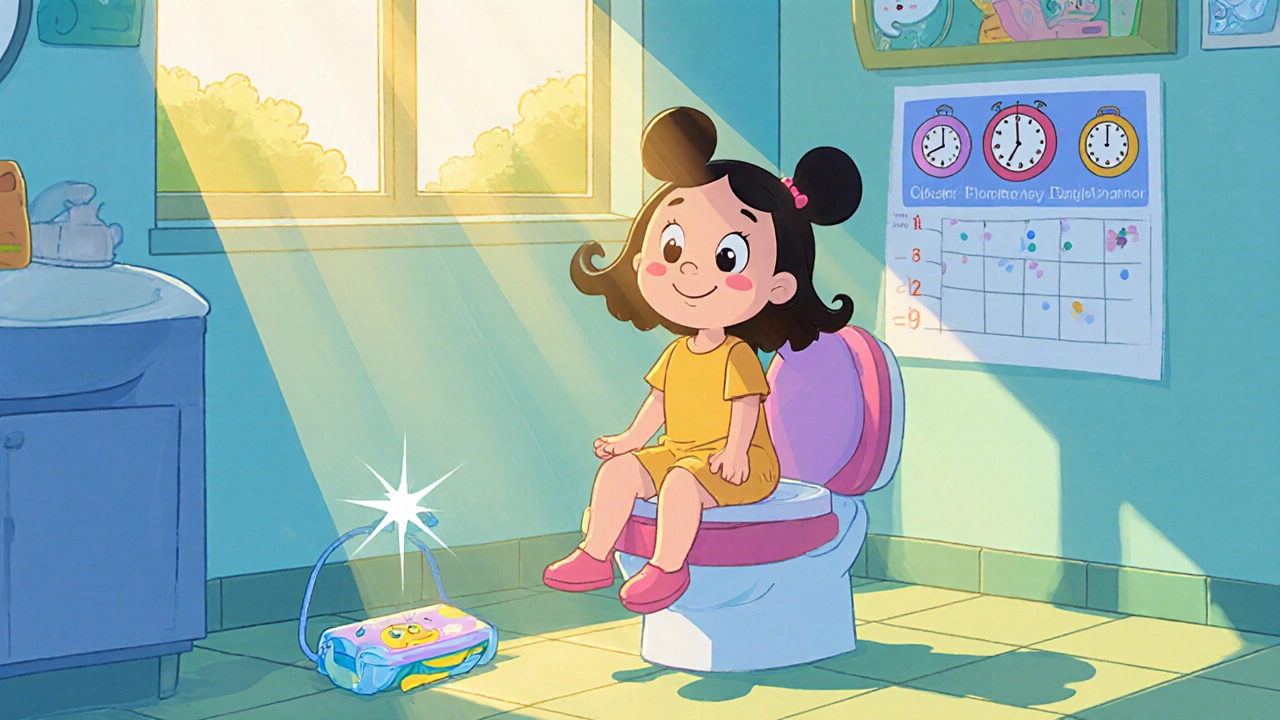How Spina Bifida Leads to Bladder and Bowel Problems

Bladder Management Calculator
Your Child's Bladder Details
Recommendation
Enter values above to calculate optimal schedule
When a baby develops Spina Bifida is a birth defect where the spine and spinal cord don’t close completely during early pregnancy, the nerves that control the bladder and bowel can be affected. This article explains why those urinary and digestive issues happen, how doctors spot them, and what families can do to keep daily life as normal as possible.
What Is Spina Bifida?
Spina bifida is an umbrella term for several neural‑tube defects that occur in the first month of gestation. The most common form, myelomeningocele, leaves a sac of exposed nerves protruding through an opening in the vertebrae. Even the milder forms, such as occulta, can interrupt the nerve pathways that travel to the pelvic organs.
Because the spinal cord carries the signals that tell the bladder to store or release urine and the bowel to move stool, any interruption in those pathways can turn a simple reflex into a chronic management challenge.
How Spina Bifida Affects the Nervous System
The sacral nerves (S2‑S4) are the primary controllers of the urinary sphincter, detrusor muscle, and anal sphincter. In myelomeningocele, these nerves are often damaged or malformed, leading to what doctors call a "neurogenic" bladder or bowel. The term "neurogenic" simply means the problem originates from the nervous system rather than the organ itself.
Imaging studies-prenatal ultrasound, fetal MRI, and post‑natal MRI-help clinicians see where the lesion sits. Lesions low on the spine (lumbar or sacral) are more likely to cause severe bladder and bowel dysfunction because they sit closer to the pelvic nerves.
Bladder Problems Linked to Spina Bifida
About 80% of children with myelomeningocele develop some form of neurogenic bladder. The most common issues are:
- Urinary incontinence: Involuntary leakage caused by an over‑active detrusor muscle or a weak sphincter.
- Urinary retention: The bladder doesn’t empty fully, raising the risk of infections.
- High‑pressure bladder: Can damage the kidneys over time if untreated.
Urodynamic testing-where a tiny catheter measures pressure inside the bladder-helps doctors classify the pattern (over‑active vs. under‑active). This classification guides treatment: medication, clean intermittent catheterization (CIC), or even surgery.
Bowel Problems Linked to Spina Bifida
Gut issues affect roughly 70% of individuals with spina bifida. The main problems are:
- Constipation: Slow colonic transit due to reduced nerve signaling.
- Fecal incontinence: Loss of control over the anal sphincter.
- Encopresis: Accidental passage of stool, often mixed with mucus.
Because the same sacral nerves manage both bladder and bowel, it’s common for a child to experience both urinary and gastrointestinal symptoms simultaneously.

Assessment and Diagnosis
Early detection is key. Here’s the typical work‑up timeline:
- Prenatal screening: Detailed ultrasound at 18-22 weeks can flag a spinal defect.
- Post‑natal physical exam: Checks for sacral dimples, skin lesions, or motor deficits.
- Urodynamics: Determines bladder pressure, capacity, and flow.
- Anorectal manometry: Measures pressure in the anal canal to gauge sphincter strength.
- Renal ultrasound: Looks for hydronephrosis that can result from high bladder pressure.
These tests give a clear picture of how the nervous system is influencing the pelvic organs.
Management Strategies for Bladder Issues
Doctors aim to protect the kidneys, achieve continence, and make the routine as simple as possible.
- Clean Intermittent Catheterization (CIC): Inserting a small catheter several times a day to empty the bladder completely. Studies show CIC reduces infection rates by up to 60% compared with indwelling catheters.
- Anticholinergic medications (e.g., oxybutynin) relax the detrusor muscle, lowering pressure.
- Botox injections into the bladder wall can provide temporary relief for over‑active bladders.
- Bladder augmentation surgery - expanding bladder capacity with a piece of intestine - is reserved for severe cases.
Management Strategies for Bowel Issues
Effective bowel care hinges on establishing a predictable schedule.
- Timed toileting: Setting a regular 15‑minute window after meals to encourage stool passage.
- High‑fiber diet + adequate fluids to soften stool.
- Laxatives or stool softeners (e.g., polyethylene glycol) when needed.
- Digital stimulation or suppositories for children who can’t feel the urge.
- Antegrade continence enemas (ACE) - a surgically created pathway that flushes the colon from the top down.
When both bladder and bowel programs are coordinated, families report a 40% drop in emergency department visits.

Living with Neurogenic Bladder and Bowel Dysfunction
Beyond medical treatment, daily life adaptations matter.
- Use of waterproof bedding and clothing reduces anxiety about leaks.
- School plans: A written accommodation that outlines catheterization times and bathroom access.
- Psychological support: Children often feel embarrassed; counseling helps build confidence.
- Parent support groups - both online and local in Melbourne - share tips on equipment, insurance, and navigating the health system.
Technology is also evolving. Wearable sensors that detect bladder fullness are in early trials and could soon alert families before an accident occurs.
Key Takeaways
Spina bifida disrupts the sacral nerves that control the bladder and bowel, leading to a spectrum of urinary and digestive problems. Early diagnosis with imaging and urodynamic testing, coupled with a structured bladder‑and‑bowel program, can preserve kidney function, improve continence, and boost quality of life.
| Area | Typical Symptom | Impact on Daily Life |
|---|---|---|
| Bladder | Urinary incontinence | Frequent diaper changes, social anxiety |
| Bowel | Constipation or fecal incontinence | Timed toileting, diet adjustments |
Frequently Asked Questions
Can prenatal surgery reduce bladder problems?
Yes. The Management of Myelomeningocele Study (MOMS) showed that fetal closure before 26 weeks lowered the incidence of high‑pressure bladder by about 30% compared with post‑natal repair.
Is clean intermittent catheterization painful?
Initially it may feel odd, but with proper lubrication and technique most children adapt within a few weeks. Pain is uncommon unless the catheter is too large.
How often should urodynamic testing be done?
Guidelines recommend at least once a year for children under five, then every two to three years, or sooner if symptoms change.
What dietary changes help with bowel control?
A high‑fiber diet (fruits, vegetables, whole grains) plus at least 1.5L of water daily can reduce constipation. Some families add probiotic‑rich foods to improve gut motility.
Are there long‑term kidney risks?
If high bladder pressures are left untreated, they can cause reflux and chronic kidney disease. Regular monitoring and early intervention keep the risk low.

Honestly, the US healthcare system does a decent job getting kids with spina bifida the urodynamic testing they need early on. The fact that we have specialists who can set up clean intermittent catheterization programs nationwide is a real win. Families here can also tap into insurance plans that cover the pricey bladder augmentation if it ever becomes necessary. It’s a solid foundation compared to many other countries.
The neurogenic cascade described here is a stark reminder that the body is an intricate tapestry of signals, each thread pulling at the next. When the sacral nerves are compromised, the bladder becomes a rebellious organ, refusing to heed the brain's commands. It is almost tragic how a prenatal defect can echo through a child's entire existence, shaping daily rituals around emptiness and retention. One must, however, critique the lack of holistic approaches that integrate mental health with the physical regimen. The clinical focus on catheterization sometimes obscures the emotional toll.
Spina bifida throws the whole pelvic signalling into chaos its like an unscripted drama the nerves forget their cues the bladder overreacts the bowel protests
Doctors try to restore order with urodynamics but the pressure spikes are like plot twists that no one wanted
Clean intermittent catheterization becomes the daily rehearsal everyone dreads yet must perform
And then there are the high‑pressure warnings that whisper of future kidney betrayals
Most folks think any spinal defect automatically means the worst bladder scenario, yet the lesion level really decides the script. Low‑lying lesions tend to wreak more havoc on the sacral plexus, but higher lesions can sometimes spare the pelvic nerves. Still, the variance is fascinating, and it’s crucial to tailor each care plan to the exact anatomy.
A good night’s sleep is priceless.
From a clinical perspective, the early implementation of urodynamic studies is indispensable for risk stratification. The literature consistently demonstrates that proactive bladder management reduces the incidence of renal insufficiency. Moreover, standardized bowel protocols have been shown to lower emergency department visits by approximately forty percent. It is therefore incumbent upon multidisciplinary teams to adopt these evidence‑based pathways without delay. The data speaks unequivocally.
While the protocols sound solid, I can’t help but feel they sometimes overlook the day‑to‑day struggle families endure 😔. The emphasis on equipment is great, yet the emotional weight of constant catheter changes is rarely addressed. A balanced view would acknowledge both the medical wins and the lived challenges.
Our nation prides itself on medical innovation, and the progress in spina bifida care is proof of that. Families here benefit from cutting‑edge research and funding that many other countries can only envy 😊. Let’s keep pushing the boundaries for even better outcomes.
The intricate dance between bladder pressure and kidney health is a compelling reminder of bodily interdependence. It’s remarkable how timed toileting can synchronize with meal patterns to improve bowel regularity. Such nuanced strategies deserve wider recognition.
When you first hear about neurogenic bladder, you might picture a simple inconvenience, but the reality is far more profound.
Each morning begins with a ritual that feels like a negotiation with one’s own body, trying to convince a stubborn detrusor to relax.
The pressure readings on the urodynamic monitor become a silent alarm, warning of potential kidney damage that lurks in the shadows.
Families often find themselves trapped in a cycle of catheterization, medication adjustments, and relentless appointments.
It’s not just about the physical act of emptying the bladder; it’s the emotional toll of watching a child grow up with a schedule dictated by medical necessity.
Even the simplest social outing can become a logistical nightmare, requiring portable catheters, sterile wipes, and a discreet bathroom plan.
The bowel side of the equation adds another layer of complexity, as constipation can precipitate painful bowel movements and accidental leaks.
Timed toileting, once hailed as a miracle solution, now feels like a constant reminder that the body’s natural rhythms have been hijacked.
Every dietary tweak, from fiber‑rich meals to probiotic supplements, is weighed against the risk of worsening incontinence.
Doctors may prescribe laxatives, but the side effects can be just as disruptive, causing bloating and cramping that interfere with school and play.
Meanwhile, surgical options such as ACE procedures loom on the horizon, promising relief but also carrying the fear of invasive intervention.
Insurance battles become another front in this war, as families fight for coverage of essential supplies and specialist visits.
The psychological impact cannot be overstated; children often internalize a sense of shame, hiding the reality of leaks from peers.
Support groups emerge as lifelines, offering shared experiences and practical tips that no textbook can provide.
Technology, too, offers a glimmer of hope, with experimental sensors that might one day alert parents before a bladder overflow occurs.
In the end, the journey is a marathon of adaptation, resilience, and constant vigilance, underscoring the profound ways a spinal defect reshapes every facet of daily life.
It is essential to approach this condition with both compassion and rigor. Establishing a consistent bladder program can be likened to building a solid foundation upon which future health rests. Encourage families to view each catheterization as a step toward preserving renal function. In doing so, we nurture both physical well‑being and confidence.
The philosophical underpinnings of neurogenic management often get lost amid the procedural checklist. Yet, the very act of controlling a bodily function reflects our deeper desire for autonomy. It is commendable, however, that some guidelines remain vague, demanding a more assertive national stance on comprehensive coverage.
Imagine the daily drama of a child whose bladder refuses to cooperate, turning each bathroom break into an act of suspense. The parents, cast as steadfast protagonists, must navigate a script written in catheters and medication doses. Their resilience becomes the unseen heroism, oft unnoticed by casual observers. Yet the narrative does not end there; the bowel’s rebellion adds a second act, demanding equal dedication. In the end, the story is one of relentless perseverance, not just medical management.
While the article covers the basics, it glosses over the socioeconomic barriers that many families face. A more critical lens would highlight how uneven access to specialized care perpetuates disparities. It’s a point worth emphasizing for any comprehensive discussion.